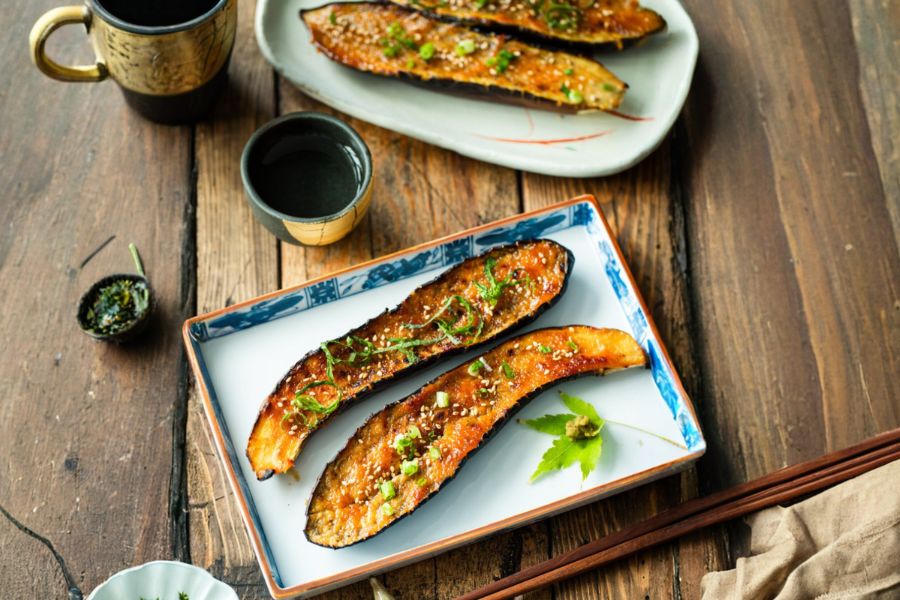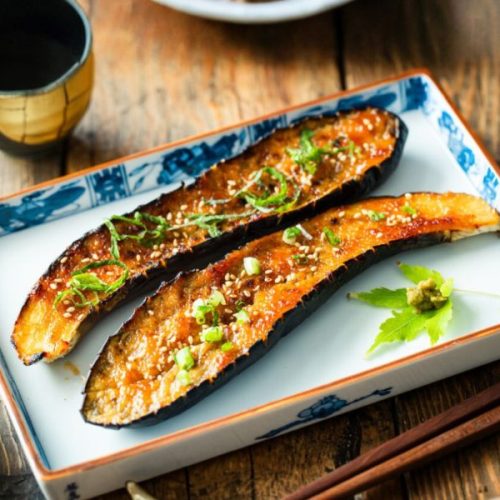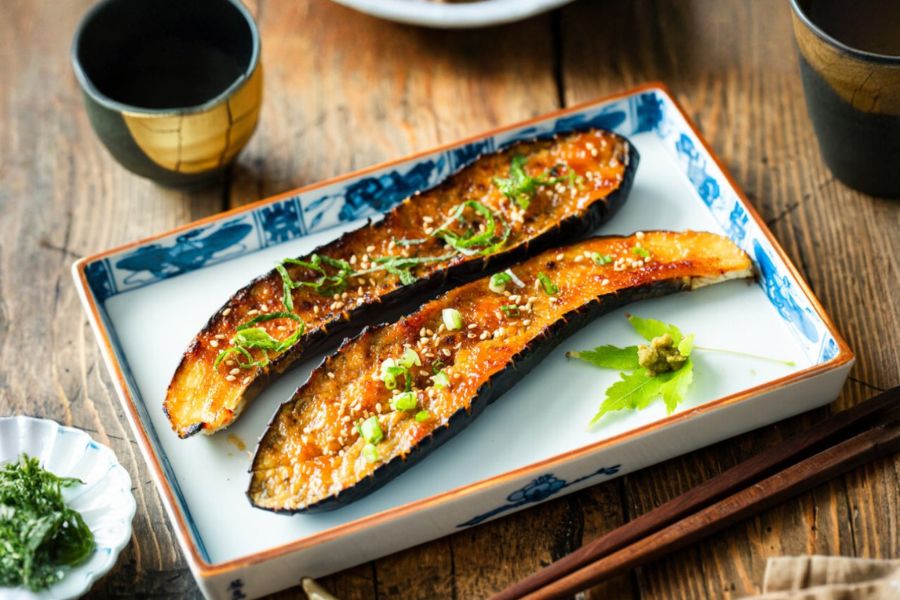Miso-Glazed Eggplant is a standout dish for both flavor and nutrition.
Its tender, caramelized eggplant pairs perfectly with a lightly sweet, savory miso glaze, creating a depth of umami that satisfies without heaviness.
This plant-based dish is rich in fiber and low in saturated fat, supporting digestive health while keeping calories moderate.
Toasted sesame oil adds heart-healthy monounsaturated fats, while the miso provides a subtle boost of protein and probiotics.
Quick to prepare and easy to bake and broil, it’s perfect for busy weeknights or meal prep.

With its elegant presentation and balance of creamy, caramelized textures, this recipe is ideal for elevating everyday meals or impressing guests without complicated techniques.
Must-Have Tools for Perfect Results
Baking Sheet
Essential for evenly roasting eggplant halves. A sturdy baking sheet ensures caramelization without burning and serves countless roasting and baking tasks in your kitchen.
Parchment Paper
Prevents sticking and simplifies cleanup. It’s invaluable for roasting, baking, and even rolling out dough.
Sharp Knife
Critical for scoring the eggplant and cutting garnishes. A reliable chef’s knife makes prep faster and safer for any vegetable or protein.
Small Mixing Bowl
Ideal for blending the miso glaze evenly. Mixing bowls are versatile for sauces, dressings, and marinating ingredients.
Broiler or Oven Rack
Provides precise heat placement to caramelize the glaze. Broilers are versatile for finishing dishes, crisping vegetables, or browning proteins quickly.

30-Minute Miso Glazed Eggplant
Equipment
- 1 Baking sheet
- Parchment Paper (1 sheet)
- 1 Chef’s Knife
- 1 Small Mixing Bowl
- 1 Oven/Broiler Rack
Ingredients
Sweet Miso Glaze:
- 3 tbsp miso white or mild
- 1 tbsp sugar
- 1 tbsp mirin
- ½ tbsp sake or water as needed
Eggplant:
- 3 Japanese eggplants approx. 1.2 lb / 518 g
- 1 tbsp toasted sesame oil
- Garnish Optional:
- 1 green onion thinly sliced
- 5 shiso leaves julienned
- 2 tsp toasted white sesame seeds
Instructions
- Prepare the Glaze: In a small mixing bowl, combine the miso and sugar, stirring until the sugar fully dissolves. Add the mirin and sake gradually, whisking to create a smooth, pourable glaze. Adjust the consistency with a little more liquid if your miso is thick. Set aside so the flavors meld while preparing the eggplant.
- Trim and Slice Eggplants: Rinse the eggplants and cut off the stems. Slice each eggplant in half lengthwise to create boat-shaped halves, or crosswise if they are long. Using a sharp knife, score the cut surface in a diagonal crisscross pattern about ⅛ inch deep to help the eggplant absorb the glaze and cook evenly.
- Soak and Dry Eggplants: Place the sliced eggplants in a bowl of water for 10 minutes to reduce any bitterness. Drain thoroughly and pat completely dry with a kitchen towel or paper towels. Moisture removal ensures even roasting and prevents soggy textures.
- Oil and Arrange: Brush the cut surfaces with toasted sesame oil, then arrange the eggplants cut side down on a parchment-lined baking sheet. Position them so they are evenly spaced, allowing hot air to circulate for uniform roasting.
- Bake Eggplants: Place the baking sheet in the preheated oven at 425ºF (220ºC) for 15 minutes. The eggplants should soften, and the skin will start to wrinkle slightly. Meanwhile, prepare garnishes such as thinly sliced green onions and julienned shiso leaves.
- Apply Glaze and Broil: Flip the eggplants cut side up and brush a generous layer of the prepared miso glaze over the surface Transfer to the broiler, keeping the oven rack about 7 inches from the heating element. Broil for 3–5 minutes until the glaze bubbles and lightly caramelizes, watching closely to avoid burning.
- Garnish and Serve: Remove the eggplants from the oven and sprinkle with toasted sesame seeds, sliced green onions, and shiso strips. Serve immediately, optionally adding a touch of yuzu kosho for a bright, spicy kick. Leftovers can be stored in an airtight container in the fridge for up to 3 days.
Notes
- Use Japanese eggplants if possible, as their thin skin and mild flavor make them ideal for this dish.
- Scoring the eggplant flesh is key—it allows faster cooking and helps the glaze sink deeper.
- If you don’t have sake, water is a fine substitute to loosen the glaze.
- Keep a close eye while broiling; the glaze caramelizes quickly and can burn in seconds.
- Leftover miso glaze freezes beautifully—make extra and save time for future meals.
- Shiso leaves add freshness, but you can substitute with fresh basil or mint if unavailable.
- For a spicier touch, serve with yuzu kosho or a small drizzle of chili oil.
Chef’s Secrets to Flawless Eggplant
The secret to perfectly glazed eggplant lies in three small steps: scoring, soaking, and drying.
Scoring ensures that the eggplant flesh cooks evenly and readily absorbs the miso glaze.
Soaking in water briefly draws out any bitterness, resulting in a cleaner, sweeter flavor.
Finally, thoroughly drying before roasting helps the eggplant achieve a creamy interior without becoming soggy.
Another pro tip is to use high heat initially, which softens the flesh, followed by a quick broil to caramelize the glaze for a glossy, flavorful finish.
These small details transform a simple vegetable into a restaurant-worthy dish.
Serving Suggestions and Pairing Ideas
Miso-glazed eggplant shines as both a side and a main component of a meal.
Pair it with steamed rice and miso soup for a comforting, traditional Japanese spread.
For a heartier plate, serve it alongside grilled fish, teriyaki chicken, or tofu.
The sweet-savory glaze also pairs beautifully with crisp vegetables such as cucumber salad or lightly pickled radishes, which balance its richness.
For a modern twist, slice the glazed eggplant and serve it over soba noodles or quinoa bowls, topped with extra sesame seeds for crunch.
Its versatility makes it equally suited for casual weeknight dinners or elegant dinner parties.
Storage Tips for Lasting Freshness
This dish is best enjoyed fresh, but it also keeps well for later.
Store cooled leftovers in an airtight container in the refrigerator for up to three days.
When reheating, use a toaster oven or broiler rather than the microwave to revive the caramelized texture.
If you’ve made extra miso glaze, keep it refrigerated for up to a week or freeze it for a month in small portions for easy use.
To meal-prep, roast the eggplant in advance and glaze it just before serving to preserve the dish’s signature glossy finish and fresh aroma.
Frequently Asked Questions (FAQs)
1. Can I use regular globe eggplants instead of Japanese ones?
Yes, though Japanese eggplants are preferred for their tender skins and mild taste. If using globe eggplants, slice them into rounds or smaller halves to ensure they cook through evenly.
2. What type of miso works best?
White miso (shiro miso) is ideal because it’s mild and slightly sweet, balancing well with sugar and mirin. Red miso can be used but will create a stronger, saltier flavor.
3. Can I make this dish without alcohol?
Absolutely. Replace sake with water or vegetable broth. You’ll still achieve a smooth glaze with plenty of flavor, though without the subtle depth sake provides.
4. How do I prevent the glaze from burning under the broiler?
Keep the oven rack about 7 inches from the heating element and watch closely after the first 2 minutes. The glaze should bubble and caramelize without turning dark or bitter.
5. Is this recipe suitable for meal prep?
Yes. Bake the eggplants ahead of time and store them plain. Add the glaze and broil just before serving. This method keeps the texture fresh and prevents sogginess.
This recipe has been adapted and simplified from the original version by justonecookbook. We’ve refined the steps for a smoother cooking experience and added helpful notes, nutrition insights, and essential kitchen tools to make it even easier for home cooks.

